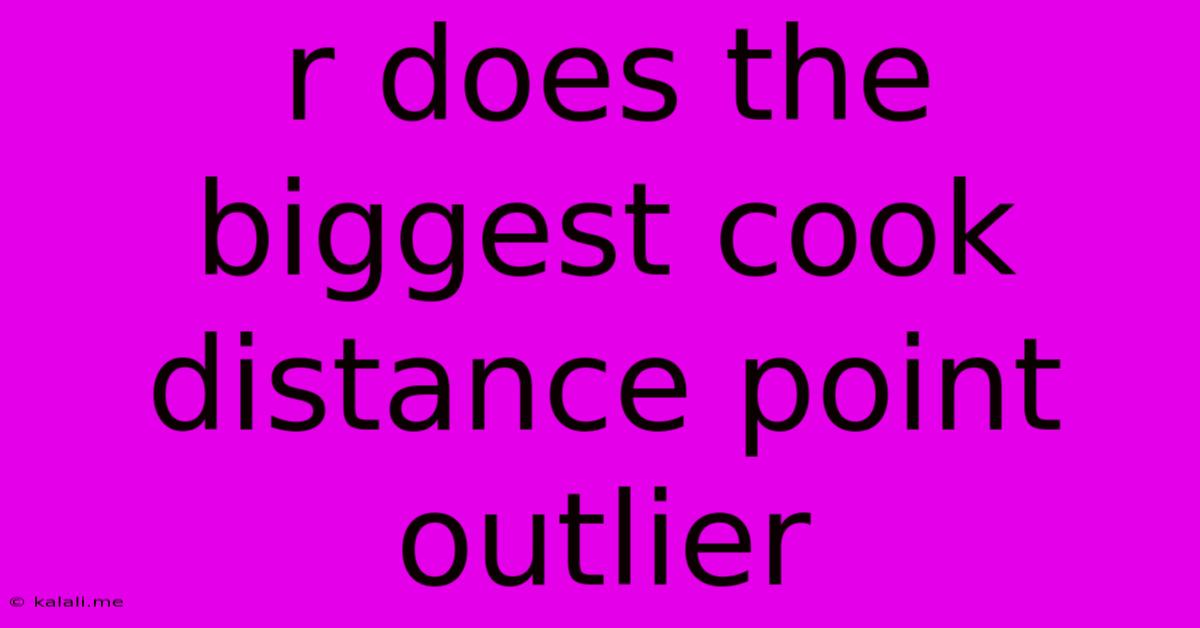R Does The Biggest Cook Distance Point Outlier
Kalali
Jun 06, 2025 · 4 min read

Table of Contents
Does the Biggest Cook's Distance Point Indicate the Most Influential Outlier in R?
Cook's distance is a common diagnostic tool in regression analysis used to identify influential observations. It measures the impact of removing a single data point on the regression coefficients. A large Cook's distance suggests that removing that point would significantly alter the regression model. But does the point with the largest Cook's distance always represent the single most influential outlier? The short answer is: not necessarily. While it's a strong indicator, it's crucial to understand its limitations and consider other diagnostic measures for a comprehensive assessment.
This article will delve into the nuances of Cook's distance in R, exploring its strengths, limitations, and how to interpret it alongside other diagnostic tools for a more robust outlier detection strategy. We'll cover how to calculate and visualize Cook's distance, and discuss when a high Cook's distance might not be the whole story.
Understanding Cook's Distance
Cook's distance quantifies the overall influence of a data point on the regression model. It considers both the leverage (how far the predictor values are from the mean) and the residual (the difference between the observed and predicted value) of each observation. A high Cook's distance indicates that removing the point would substantially change the regression coefficients, potentially altering the model's conclusions.
In R, Cook's distance is easily calculated using functions from the stats package (which is loaded by default). Functions like lm.influence() provide the necessary information. Visualizing it using a plot can quickly identify potential influential points.
Limitations of Relying Solely on Cook's Distance
While Cook's distance is a valuable tool, relying solely on it can be misleading. Here's why:
- Masking Effect: A single highly influential point can mask the influence of other points. The largest Cook's distance might overshadow other potentially influential observations.
- Multicollinearity: In cases of high multicollinearity (strong correlation between predictor variables), Cook's distance might not accurately reflect the influence of individual points. The influence is distributed across multiple variables, making it harder to pinpoint a single culprit.
- Leverage and Residuals: Cook's distance is a combination of leverage and residual. A point with high leverage (far from the mean of predictors) can have a large Cook's distance even with a small residual, and vice-versa. This means the largest Cook's distance doesn't always correspond to the point with the largest residual.
Complementary Diagnostic Tools
For a more comprehensive analysis, consider using these tools alongside Cook's distance:
- Leverage: Identifies points with extreme predictor values. High leverage points have the potential to greatly influence the regression line, regardless of their residuals. The
hatvalues()function in R provides leverage values. - Studentized Residuals: These residuals are adjusted for the variance of each observation, providing a better indication of outliers with large residuals. The
rstudent()function in R calculates studentized residuals. - DFFITS: Measures the change in predicted values when a point is removed. A large DFFITS value indicates that the point significantly influences the predicted value for that observation.
- DFBETAS: Measures the change in regression coefficients when a point is removed. Large DFBETAS values suggest that the point substantially affects the estimated coefficients.
A Holistic Approach in R
Effective outlier detection requires a holistic approach. Don't rely on Cook's distance alone. Instead, employ a combination of diagnostic plots and metrics:
- Calculate Cook's distance, leverage, studentized residuals, DFFITS, and DFBETAS: Use the appropriate functions in R (
lm.influence(),hatvalues(),rstudent(), etc.) from the model object produced bylm(). - Visualize Cook's distance: Create a plot to easily identify points with high Cook's distance. Consider plotting Cook's distance against observation number or against other diagnostic measures.
- Examine leverage and residuals: Identify points with high leverage and/or large studentized residuals.
- Analyze DFFITS and DFBETAS: Investigate points with significant changes in predicted values or regression coefficients upon removal.
- Interpret the results: Consider the context of your data and the implications of removing each potentially influential point. Don't automatically remove points based solely on a high Cook's distance; understand why the point is influential.
By integrating these methods, you gain a much clearer picture of influential data points and can make more informed decisions about handling outliers in your regression analysis in R. Remember that the goal is not necessarily to remove outliers, but to understand their influence and the implications for your model's validity and interpretation.
Latest Posts
Latest Posts
-
Fill A Hole In Concrete Floor
Jun 06, 2025
-
Why Is My Audi Delayed With A New Cord
Jun 06, 2025
-
Why Apache Display Full Server Path
Jun 06, 2025
-
Do You Need An Id For A Greyhound Bus
Jun 06, 2025
-
What Is The Purpose Of A Neutral Wire
Jun 06, 2025
Related Post
Thank you for visiting our website which covers about R Does The Biggest Cook Distance Point Outlier . We hope the information provided has been useful to you. Feel free to contact us if you have any questions or need further assistance. See you next time and don't miss to bookmark.